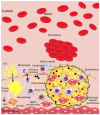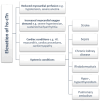From Atherosclerotic Plaque to Myocardial Infarction-The Leading Cause of Coronary Artery Occlusion
- PMID: 39000400
- PMCID: PMC11242737
- DOI: 10.3390/ijms25137295
From Atherosclerotic Plaque to Myocardial Infarction-The Leading Cause of Coronary Artery Occlusion
Abstract
Cardiovascular disease (CVD) constitutes the most common cause of death worldwide. In Europe alone, approximately 4 million people die annually due to CVD. The leading component of CVD leading to mortality is myocardial infarction (MI). MI is classified into several types. Type 1 is associated with atherosclerosis, type 2 results from inadequate oxygen supply to cardiomyocytes, type 3 is defined as sudden cardiac death, while types 4 and 5 are associated with procedures such as percutaneous coronary intervention and coronary artery bypass grafting, respectively. Of particular note is type 1, which is also the most frequently occurring form of MI. Factors predisposing to its occurrence include, among others, high levels of low-density lipoprotein cholesterol (LDL-C) in the blood, cigarette smoking, chronic kidney disease (CKD), diabetes mellitus (DM), hypertension, and familial hypercholesterolaemia (FH). The primary objective of this review is to elucidate the issues with regard to type 1 MI. Our paper delves into, amidst other aspects, its pathogenesis, risk assessment, diagnosis, pharmacotherapy, and interventional treatment options in both acute and long-term conditions.
Keywords: atherosclerosis; cardiovascular disease; myocardial infarction.
Conflict of interest statement
The authors declare no conflicts of interest.
Figures




References
-
- Thygesen K., Alpert J.S., Jaffe A.S., Chaitman B.R., Bax J.J., Morrow D.A., White H.D., Executive Group on behalf of the Joint European Society of Cardiology (ESC)/American College of Cardiology (ACC)/American Heart Association (AHA)/World Heart Federation (WHF) Task Force for the Universal Definition of Myocardial Infarction Fourth Universal Definition of Myocardial Infarction. J. Am. Coll. Cardiol. 2018;72:2231–2264. doi: 10.1016/j.jacc.2018.08.1038. - DOI - PubMed
Publication types
MeSH terms
LinkOut - more resources
Full Text Sources
Medical
Miscellaneous

